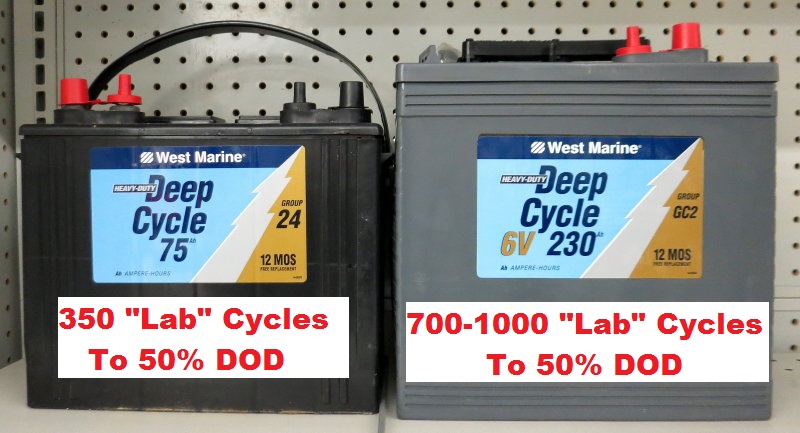Light Cycle vs. Deeper Cycle
NOTE: This article deals with FLOODED marine batteries, not AGM or GEL batteries.
The Problem:
The problem, as I see it, is one of dishonest marketing where multiple battery types wear the same clothes (sticker) and will perform differently when placed into a deep cycling situation. Sadly, the standards board in the USA, Battery Council International (BCI), allows for this foolishness.
Does this mean a Group 24, 27 or 31 battery can’t and won’t work? Absolutely not, it just means that when compared to a battery that is actually designed, built and intended for deep cycling activity, such as golf car, sweeper scrubber or fork truck batteries a Group 24, 27 or 31 flooded battery simply is not the same, cycle-wise, despite the “sticker” suggesting to a buyer that it is.
Unfortunately the industry has no real marketing definition of what “deep cycle” means so any battery a manufacturer feels they want to slap a “deep cycle” sticker on, gets one. This range of deep cycle labeled batteries spans all the way from a Group 24 12V automotive cased battery up to and including massive 15-20 year expected life 2V cells used in stationary applications. A 2V cell is obviously more “deep cycle” than even golf car, fork truck or sweeper scrubber batteries but all may wear the same deep cycle sticker. If you buy batteries more carefully, you can get more life out of them, for your dollar.
As a marine electrician I get to see, replace and test lots and lots of batteries. Because of this I also need to know quite a bit about batteries, how they work, how they charge, how they cycle, which ones are best suited for the application and above all else, how they are marketed. Suffice it to say, this last point, the marketing, is my biggest bone of contention.
I also test batteries for their actual Ah capacity ratings on a near daily basis. As I type this I have two 20 hour tests in-process. When I began doing actual 20 hour testing, about 17-18 years ago, my set up was crude but it worked OK. I quickly began to see a sharp differentiation between how 12V Group 24, 27, 31, 4D & 8D batteries were holding up when compared to industrial use deep cycle batteries such as golf cart, L16’s J305’s etc.. As time moved on I invested more money into better capacity testing & charging equipment to get much more repeatable and more accurate capacity data. My test stations even include temp controlled water-baths so battery temp is not a factor.
On occasion I hit a point where I become so frustrated with bovine-dung marketing that I must simply explain myself. What I believe should be obvious, is not always so obvious, especially when the marketing departments muddy the waters. This article is one of those cases where I have simply had enough of the bovine-dung and have to get this out there so boaters will have a better understanding of what they are really getting, or not getting, when they plunk down a pile of greenbacks for a set of “deep-cycle” batteries. Let this rant begin…….(wink)
First let me summarize this article in a sentence or so. This is so you can bypass the wordy diatribe if you must..
Group 24, 27 & 31 & most *4D & *8D flooded 12V “Marine Batteries” are NOT really a deep-cycle battery when compared to a battery specifically designed from the ground up as a “deep cycle” battery. Simple stuff.
*There are only two companies I know of producing 4D or 8D deep cycle flooded batteries, comparable to Golf Car batteries in terms of cycling, and they are Dyno and Rolls.
There are 2V, 6V and 12V flooded batteries that are better suited to cycling duty than the typical Group 24, 27, 31 , 4D or 8D automotive cased batteries. If you have the height to fit 6V or 12V golf car, sweeper scrubber or industrial batteries you certainly can get a lot more for your money.
Battery Buying Misinformation: “You purchase deep-cycle batteries based on Ah & cost“
Battery Buying Reality: You purchase deep-cycle batteries based on Ah, cost and cycle-life
If you’re failing to include “cycle-life” in the battery buying calculation you are only robbing yourself..
Let’s go through how far too many boat owners buy batteries;
#1 Boat owner walks into West Marine or battery dealer and says “I need a new battery for my boat.” Dealer or West Marine associate says “What size?” and the owner says “They look like that.” The associate then asks whether the boat owner will be starting the motor only or starting the motor and using electronics with it? Owner answers yes about starting and electronics and walks out with a 12V group 24, 27 or 31 “Marine Dual Purpose” battery for a deep-cycling application…. This transaction = FAIL
#2 Boat owner walks into West Marine or battery dealer and says “I want a house bank battery with the most capacity.” Associate looks at the reserve capacity (RC) or Reserve Minutes (RM) rating and tells the buyer; “Here’s a Group 24 130Ah battery.“. The boat owner leaves thinking he just bought a massive 130Ah Group 24 12V battery. Sadly, no such battery exists on this planet. D’oh… This transaction = FAIL
There are plenty more scenarios I could play out here but the main point is that the average boat owner often has little understanding of how to buy & choose a battery properly suited for deep-cycling use.
Deep cycle use, for most battery manufacturers, is considered drawing the battery to 50% state of charge, on a fairly regular basis. The boat owner however is not alone in their lack of education because, even the associates at many battery retailers don’t have a clue about the products they are selling.
It is not my intent to pick on West Marine in this article but seeing as they have the published data in their catalog, which most battery buyers entirely miss or gloss-over on, I thought I would walk through the battery buying process for the average flooded battery buyer so that you, as a battery owner, are armed with information to purchase the right batteries for your vessel.
Key Points:
Ampere Hours (Ah’s) and Reserve Capacity / Reserve Minutes (RC) are not one in the same nor are they interchangeable. You want to purchase house bank cycling batteries based on the Ampere Hour rating at the 20 hour rate not the Reserve Capacity or Reserve Minutes rating. If the battery does not have a 20 hour Ampere Hour rating it is generally best to simply walk away, or find out who actually made the battery.
When I say “who made the battery” I am talking about the physical manufacturer, not the re-seller who simply slapped a sticker on it. You then call the manufacturer and find out the 20 hour Ah capacity rating for that battery, if it even has one. Some batteries are tested for a 20 hour rating but the sticker brands often leave this data off.
Worse yet is that some Group 24, 27 31 etc. batteries have their 20 hour rating “calculated” from a reserve minute or reserve capacity testing. What? All this means is the battery you may be buying was never physically tested for an actual Ah rating and they used a mathematical calculation to try and predict the 20 hour rate. An RC test is is usually conducted at 25A and an Ah capacity test is one which allows the battery to run for 20 hours at the 20 hour discharge rate. For a 100Ah battery this would be 5A. That same battery when tested for reserve capacity would be discharged at a 25A rate. The mathematical translations from RC to Ah capacity do not always work out accurately. Many Group 24, 27, 31 etc. batteries, that I have tested, have a very, very tough time delivering their actual Ah capacity rating even when new and cycled for break in.
Misleading Marketing:
Not all marketed “Deep Cycle” batteries are in fact Deep Cycle batteries. The vast majority of 12V flooded batteries sold as “Marine Deep Cycle” are not really what should be considered a deep cycle battery. I often refer to 12V flooded deep cycle batteries as light cycling or pseudo deep cycle batteries. While there are a few exceptions to this rule, such as 12V golf cart batteries and 12V sweeper/scrubber batteries, you won’t find them most marine retailers such as a West Marine.
As mentioned above Group 24, 27, 29, 30, 31, & most 4D & 8D flooded batteries are simply not a deep cycle product when compared to a battery such as a golf car battery, sweeper/scrubber battery or any other industrial application deep cycle batteries. GC2 6V batteries usually cost less than 12V batteries on a per ampere hour basis and also usually yield double the lab cycle life rating or more..
The term “Deep Cycle” has been badly bastardized by the industry to the point that it is almost entirely meaningless. You as the buyer should educate yourself as to what really represents a good value before buying batteries..
Deep Cycle Battery Questions to ask Yourself:
- What is the 20 hour Ah rating?
- What is the “lab rated” cycle life of the battery when compared to other batteries within its own brand?
- What is the Cost per Ah?
- What is the cost per lab-cycle?
- What is the largest Ah capacity battery I can fit?
- Can the manufacturer provide you a Peukerts constant so a battery monitor can be programmed?
- Is this a good quality battery made by a reputable manufacturer?
- Who actually manufactured this battery? (Not who put the sticker on it?)
- What is the warranty? (do not get hung up on this)
What is the most important part of this equation, that is almost always left out? If you guessed step #2, you win!!!!
Lets use the points just made to purchase the pictured batteries:
Group 24 “Deep Cycle” 12V:
- Group 24 Deep Cycle = 75 Ampere Hours or 150Ah’s for two. (you’d need two of them for any usable house bank)
- Group 24 Deep Cycle = 350 lab rated cycles to 50% DOD
- Cost per Ah = $2.07 For a 150Ah bank
- Cost Per Lab Deep Cycle = 97¢ *per cycle – *expect half the rated cycles/real world = $1.94/Cycle
Group GC2 6V “Deep Cycle” (requires two for a 12V bank):
- Group GC2 6V = 230 Ampere Hours (two 6V batteries in series = 12V bank)
- Group GC2 Deep Cycle = 850 (took mid range) “lab rated” cycles to 50% of capacity
- Cost per Ah = $1.74 For a 230Ah bank
- Cost Per lab deep cycle = 47¢ *per cycle – *expect half the rated cycles/real world = 97¢ per lab Cycle
In virtually the same foot print as two Group 24 12V light cycle batteries, only slightly taller, two 6V batteries wired in series for 12V will yield approximately 850 lab cycles vs. 350. It will also yield 80 more amp hours of capacity in virtually the same exact foot print. The cost per Ah, based on West Marine prices, is considerably less and the cost per lab cycle is approx half. This is exactly why the battery buying calculation must always include cycle life not just Ah to $$.
My point here? Don’t forget to look into the lab rated cycle life and then purchase batteries that can theoretically deliver you the most cycles. We must remember that lab cycles are a theoretical best case for “real world” use. This cycle life data can be used as guidance within a brand. In other words lets stop focusing on what the “sticker” says, hell they all say “deep cycle”, and focus on the expected durability of the battery in a cycling application.
Fitment of Batteries:
Unless the builder has left you no additional height at all, in the battery compartment, a GC2 6V or GC-12 golf car battery can very often fit where Group 24, 27 or 31 batteries did. A GC2 (T-105) golf car battery will fit into virtually the same foot print as a Group 24 battery only it will be slightly taller..
Dual Purpose vs. Deep Cycle
Pictured here is the lab rated difference between a golf cart battery and a Dual Purpose Group 24, 27 or 31.
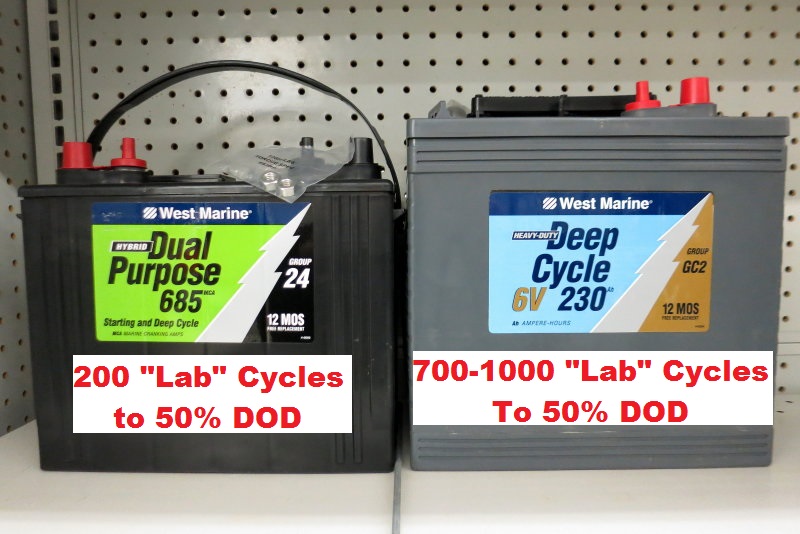
The West Marine Advisor – Cycle Life
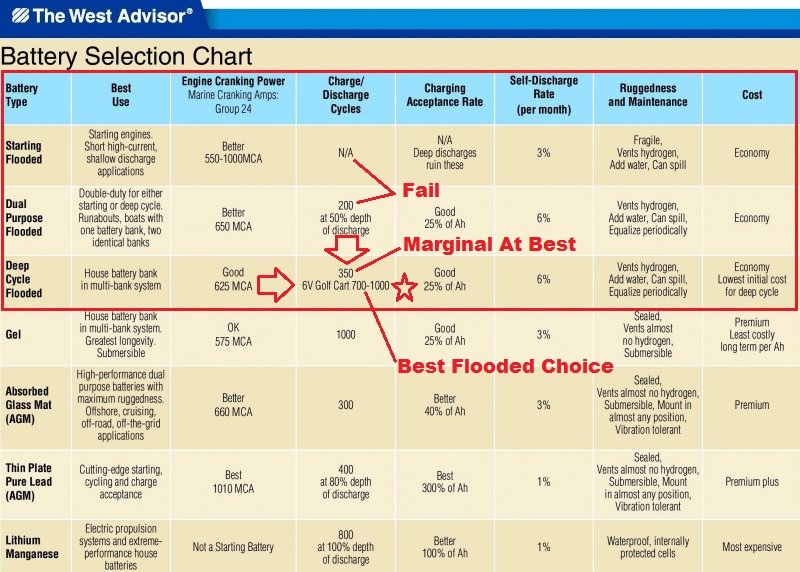
Just in case you wanted to see where you can actually reference the *data points am discussing, in regards to the West Marine Sea Volt/ East Penn product, you can find it in the West Marine catalog. This chart is on page 379 of the 2014 West Marine catalog..
When buying batteries for deep cycling use, always be sure you can get your hands on manufacturer cycle life data to compare their batteries across types. No data? No buy…….
*Data Points: I have confirmed this data to be accurate, with West Marine, to the best of their knowledge. The data in this image comes straight from West Marines supplier, East Penn Manufacturing which is also known as Deka.
East Penn Golf & L16 Chart
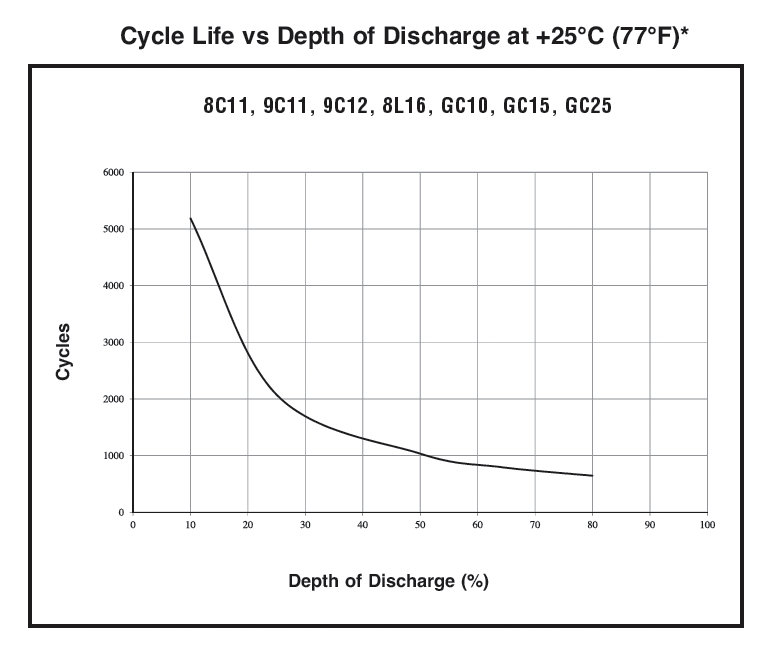
So what’s the bottom line between golf cart batteries (GC2), L16’s, J305’s, GC-12/T1275/J-150/9C12/921’s and light-cycling 12V Group 24, 27, 31 etc.? Below is the answer one of the largest US battery makers gave to us when we asked this very pointed *question. (*Source email string between Marine How To and battery manufacturer testing engineer.)
Question asked by Marine How To.com:
Q: “If the GC2, GC-12 or L16’s were cycled using the same cycle life testing as the 12V Group 24, 27, 31 etc. what would that outcome, in cycle life, actually look like? Is it fair to suggest a GC2, GC12 or L16 battery has double to triple the lab cycle life, to 50% DOD, than the 12V 24, 27 & 31 etc. “deep cycles” do?”
A: Senior Battery Engineer – Major US Battery Manufacturer:
“Yes, for packs of equivalent energy content (voltage * capacity) the Golf Car types and L16’s are 2-3 times better than the DC automotive sizes (24, 27 and 31).”
Wow! Straight from the source, golf car batteries are 2-3X better than 12V 24, 27 & 31. These flooded 12V Group 24, 27 & 31 batteries are simply marketed in a rather misleading manner.
To make an even fairer comparison I ran the numbers on a group 24 deep cycle test and a GC2 cycle test, done by the same manufacturer. Both batteries were discharged at approximately 33% of their 20 hour Ah rating, and it can’t get more apples to apples, in terms of comparable testing, than this.
The Group 24 “deep-cycle” delivered just 350 lab cycles and the GC2 golf cart battery delivered 1000 cycles when tested exactly the same way. Both batteries were tested at the same discharge rate, to the same end of life point, yet the golf cart battery delivered 650 more cycles than the 12V Group 24 “deep cycle”.
Let’s go over some terms I’ll be using in this article:
Lab Rated Cycle Life:
This term simply denotes what the battery manufacturer see’s in their own white coat, white glove, laboratory. The batteries are cycled under ideal conditions, and quite often to no industry standardized test across brands. Some might test the battery to BCIS-02 and some to BCIS-07. Some might use the 20 hour discharge rate and some might use the 5 hour or 2 hour rate for cycle life testing.
For what it’s worth some battery makers never even conduct a 20 hour test and instead this data is “calculated” from other tests that take them much less time. The batteries which are most likely to never undergo an actual 20 hour capacity tests? You guessed it “automotive sizes” or Group 24, 27, 31 etc.types. I am quoting the battery engineer with the “automotive sizes” quote.
Battery testing procedures are guided by the Battery Council International or BCI for short. The problem is there are many different cycle life testing procedures and manufacturers rarely tell you which one they use or are testing to for the specific battery in question.
I was recently at a solar trade show and two of the big gun battery makers referenced in this article were there. I asked each manufacturer to tell me which BCI test standards they used for 12V marine G-24, 27 & 31 batteries vs. golf car or other deep cycle batteries. The answers I got…. BLANK STARES.
One manufacturer then suggested the golf car batteries might be tested at a 2 hour rate and the marine batteries at a different rate. If this is so then the spread between golf cart batteries and 12V deep cycle batteries can grow even wider in the real world. Ouch!!!
Light-cycling batteries are already half of the rated cycles of a golf car type battery and they “may” be being treated with kid gloves to boot when you actually compare testing. At a best case the 12V G-24, 27 & 31 battery might be half the cycles of an actual deep cycle in the lab but they may actually be worse than half the rated cycles depending upon the testing used hence the battery engineers statement of golf car type batteries being 2-3 times better for cycling use.
This is just a sampling of some BCI Tests:
- BCIS-05 – Capacity Testing of Electric Vehicle & Cycling Batteries
- BCIS-06 – Constant Current Cycle Life Testing of Deep Cycle Batteries
- BCIS-07 – Cycle Life Testing of Batteries for Golf Carts
- BCIS-08 – Cycle Life Testing of Deep Cycle Marine/RV Batteries
What tests were used, and the differences between these tests, can result in massive variances, brand to brand, and also in their cycle life claims. This is why it is nearly impossible to use lab cycle life data across brands or manufacturers. Through in-house testing battery manufacturers can produce cycle life data across their own products, based on their own testing.
Remember these lab tests are under ideal conditions and the battery is repeatedly cycled up to full and down to the chosen DOD then back up again, all at controlled temps, discharge rate, re-charge rate, rest times and all back-to-back non-stop with no calendar aging or time to sit at 80% SOC and sulfate. These lab derived numbers have very little meaningful relationship to real world cycling performance.
Out in the real world marine batteries rarely, if ever, deliver even half the lab rated cycles, and there is good reason for this. In general, most boaters can expect 10% to as high as 60% of the lab cycles out in the real world. Some might even do better but on average I see well under 50% of the lab suggestions. The only useful lab data is lab data within a brand or manufacturer of batteries.
For example, if Deka/East Penn says their 6V GC2 golf cart battery is 700-1000 cycles, when compared to their 12V Group 24, 27 or 31 deep cycle, using the same test criteria such as BCI 2, this can be good guidance, and I stress the term guidance. It is only good guidance within the Deka/East Penn brand as to which of their batteries could be expected to deliver the most cycle,s when used in a deep cycling application. However, if Trojan suggests their 12V Group 24, 27 or 31 deep cycle marine battery (SCS-150, SCS-200 & SCS-225) have 600 cycles, you CAN NOT and SHOULD NOT compare that data to another brand or manufacturer. It is beyond meaningless to do so. Remember these companies rarely use independent external labs or standardized cycle life test procedures in direct A to A test scenarios across brands.
Real Word Cycle Life:
This one is almost impossible to nail down other than to say, from years of experience, that the average marine battery won’t usually deliver even half the cycles, in the real world, as they do in the lab. Cut lab numbers in half, at the top end, and you’ll be in better shape expectation wise.
In the real world we have so many factors that inhibit lab like results that it is nearly impossible to get anywhere close to this data. By industry standards a flooded battery is dead when it can no longer deliver 80% of its rated Ah capacity. Will a battery still work beyond this point? Absolutely, and they do, but the catastrophic failure rate, such as an internal short, starts to increases pretty steeply as the rated Ah capacity drops below this 80% figure.
The rate of internal failures I see in marine batteries is highest in 4D & 8D then group 24, 27 & 31 flooded batteries. AGM & GEL much less so but it happens with those too. It also happens in golf car batteries but to a lesser extent than I see it in “automotive” case batteries. Why? I don’t have a good answer other than to point at the separators, lightly built construction/grids etc. and lack of space below the plates. The separators are thicker in industrial batteries than they are in automotive cased flooded batteries. The last few GC2’s and group 24, 27 or 31 batteries I have autopsied showed the separators to be nearly twice as thick in the golf car batteries than they are in the automotive cased batteries.
In a recent survey of “Marine Battery Use” on Sailboatowners.com, more than 1000 sailors responded, a truly exceptional response. 79.5% of responders indicated they cycled their house banks to 50% DOD less than 25 times per year. Stack that data point on-top of the fact that 82% of responders reported less than 6 years of marine battery life and that means the vast majority of boaters are getting less than 150 real world cycles out of their marine batteries… Ouch!
While there was a large spread in cycle life between golf cart and group 24, 27 & 31 type batteries, in terms of longevity, none of these batteries tend get within half the lab ratings. Keep in mind that many of these companies claim 1200 “lab cycles”, as seen right in this article, and yet these batteries are still very often failing in less than 300 cycles of marine deep cycle use. Lab cycle life is simply a fairy tale in the marine space. The lower the lab cycle life number the worse the batteries generally perform in a real world application. Golf and industrial batteries can be murdered too, it just usually takes a bit longer.
Capacity Testing:
Unfortunately we have no widely used or widely avaialble test equipment that can accurately tell us the as-now 20 hour ampere hour capacity. It is a real crap shoot and there are lots of tools that try but all fail miserably, except for an actual 20 hour capacity test, which very few are even willing to pay for.
I do offer physical 20 hour capacity testing for my customers with expensive GEL or AGM batteries, or even expensive industrial flooded batteries, but the testing cost, per battery, for a typical sub $200.00 flooded battery, is simply not realistic. As far as I know I am the only marine electrician in the US offering this type of testing and it is EYE OPENING & SHOCKING to many owners.
*EDIT: I know Charlie Johnson of JTB Marine in Florida & Bill Trayfors of YachtSense in Annapolis have now added the equipment to test for actual Ah capacity.
You can do a capacity test yourself but it involves some set up and equipment that most boat owners may not have on hand. It also requires time and patience to do so..
Dock Talk & Battery Life Gossip:
Owner to owner, dock talk, or dock gossip is essentially as useless as boobs on a bull and not meaningful. It could only be meaningful if you have a baseline for comparison & consistency and everyone used their batteries identically, and we simply don’t. Bottom line, ignore dock talk on battery life and learn how to test your own batteries for their true deliverable Ah capacity.
I have one older customer, a delightful guy, with a beautiful classic little day sailor, he claims consistently & repeatably that he gets “7 years” out of his single 12V deep cycle battery. His basis for a failed battery is when he can no longer power his VHF radio to call the launch. Ouch! He has no motor to start, never needs running lights and uses no electronics, he’s old school and I like that! His batteries are most likely dead by year two but his VHF radio draws so little that he once was able to eek out seven years before it would not even power a brief 2A load to call the launch.
He is a battery murderer yet he does not believe nor understand it because he once had a battery last him seven years powering a VHF radio to call the launch. Flooded batteries are considered dead, by industry standards, when they can no longer deliver 80% of the new Ah capacity or 80Ah for a 100Ah rated battery. Would 80% be dead for powering a VHF radio? Absolutely not. However, in many other applications, for which the battery was intended, it would be in marginal shape at best, and would be more prone to failure.
Interestingly his last replacement battery failed internally at year 3 and became a 10 volt battery instead of 12V. Of course he still gets “7 years” out of his batteries, if you were talking to him on the dock, and he see’s no reason to change his charging or use habits. Of course, cost is not an issue for him, so why should he. I can nearly guarantee that if you were to talk to him today, on the dock, he still gets seven years because it did happen once….
This is a prime example of why dock talk is not meaningful in battery life conversations. If everyone capacity tested their batteries, and was honest about when they hit 80% of rated capacity, then we might have meaningful conversations about battery life. We’d also have a lot of owners saying “holy $hit” my batteries are dead in two years??? (head bonk)
In the real world batteries don’t die naturally, they are murdered by their owners. Here’s some of the how and why with regards to the reasons lab data does not compare to the real world.
What Kills Batteries?
- Chronic “PSOC” Use – Partial State of Charge Operation
- Temperature Abuse- Heat MURDERS BATTERIES, the engine room is the last place any battery should be.
- Poor Charging Practices
- Absorption voltages set too low
- Inadequate absorption voltage duration (under absorbing or premature floaulation)
- Incomplete or Under Charging – Alternator only for mooring sailed boats
- Over Charging – Old school non-smart chargers
- Improper Charging – Poorly designed battery chargers, there are MANY.
- No Temp Compensated Charging – If a battery charges at 14.4V this is max at 77F, not at 90F or 100F plus
- Lack Of Maintenance – Exposed plates sulfate in short order
- Contamination – Happens when batteries are not properly serviced and external contaminates get in
- Improper Flooded Battery Orientation – With respect to sail boats
- Improper Bank Wiring – Poor wiring practices can cause interbank imbalances
- Lack of Proper Equalization Charges –
- Batteries Sitting at Less Than 100% SOC – Especially for for days or weeks
Group 24 & 27 / DC24 & DC27

Here is East Penn data for the Group 24 “deep cycle”, called a DC24 (typo labeled DC25), and the group 27 called the DC27. The East Penn DC-24 and DC-27 are the same exact batteries we call “marine deep cycle” and the same exact batteries West Marine labels as Sea Volt Deep Cycle.
If we compare DC-24 & DC-27’s 80% DOD number of 200 cycles, to the previous chart at 80% DOD, we can see that indeed the golf car, L16, GC12’s etc. are performing in the lab at 2-3 times better, just as the battery engineer stated. East Penn also has data on the golf car and industrial batteries at 90F and even at 90F they still wallop the group 24, 27 & 31’s butts in terms of lab cycle life.
Starting vs. Deep Cycle

Don’t laugh, if I had a dime for every boat I have seen using starting batteries as deep cycle banks I would be much further ahead towards retirement.
What’s the difference?
Starting batteries should not be used for deep cycling, but deep cycle batteries can easily be used for most starting purposes. I use deep cycle batteries for starting on almost all sailboat installations. Why? They last longer and can be called upon for cycling if or when the house bank fails. A small aux diesel engine can be started by even a PWC battery so a decent deep cycle house bank makes easy work of motor starting.
Deep Cycle? Compared To What?

Remember what I said above about start batteries used as house banks? The battery on the far right had been replaced 3 times in 5 years. It was one of two used as the house bank. Why were starting batteries used and replaced like for like? “It’s what the boat builder shipped the boat with, so I replaced them with the same type.”
The three batteries pictured here are all made by Deka / East Penn and all share the identical case despite the internal construction being different. The two on the right are East Penn starting batteries and not even rated for deep cycles.
The battery on the left is the Deka /East Penn DC27 which is then relabeled as a Duracell DC27 and sold through Sam’s Club. This battery is rated at 350 cycles in the lab but the other two carry no cycling rating at all.
With this image it becomes very easy to see how the marketing snakes (guru’s if you must) get away with calling the DC27 a deep cycle battery. Sure, when compared to other Group 27 batteries, with which it shares a case, it is a deeper cycling battery. However when compared to a Golf Cart GC2, L16 etc. etc. or any other actual deep cycle battery it is simply an imposter.
Deep cycle? Compared to what is the question you must ask yourself….
Trojan Has Similar “Light-Cycling” Deep Cycle Batteries

Just so you don’t think I am only picking on West Marine or Deka/East Penn here is Trojan’s line up suitable for boats..
I have installed nearly all the batteries pictured in either recreational or commercial vessels.
Top Row:
The top row are the most popular deep cycle Trojan’s I see installed on cruising vessels. They are the venerable Trojan T105 6V GC2 at 225 Ah’s, and Trojan’s 12V golf cart battery called the J150 at 150Ah’s. If you don’t want to deal with 6V batteries the J150 offers identical cycling performance in a 150Ah 12V case.
Middle Row
These are Trojan’s imposter/pseudo deep cycle 12V marine batteries. They are lab rated at just half the cycle life of the top row and bottom row. Sadly all three rows are marketed as “Deep Cycle”. Is this fair or honest marketing???? You be the judge.
Bottom Row
On the left we have the 12V J185 sweeper/scrubber battery. This is 225 Ah 12V battery at 1200 lab rated cycles. It is double the lab rated cycle life of the 12V marine batteries in the middle row. On the right we have the L16 6V sweeper/scrubber battery. This model is 435 Ah and 1200 lab rated cycles to 50% DOD..
If you have the height, any of the batteries on the top or bottom row are great choices. Also please remember not to compare brand to brand cycle life data, it is guidance only within a brand or manufacturer.
Trojan Cycle Life Data – by Battery Line

Here is Trojan’s lab cycle life chart for their various lines of batteries. Both the venerable T-105 and the Group 24, 27 & 30/31 are considered “Signature Line” products but Trojan specifically breaks out the cycle life of the Group 24, 27 & 30/31 from the T-105 level batteries.
As can be seen the T-105, L16, T-125, T-145 etc. all cross the 50% DOD to lab cycles line at about 1200 cycles and the Group 24, 27 & 31 cross it at about half that or 600 cycles.
Both “Signature Line” groups of batteries get the same deep cycle label but one group delivers just half the cycles in the lab. Same sticker, half the performance…? Fair? Honest?
Let’s compare the *cost of two SCS200 Group 27’s and the cost of two T-105 GC2 batteries.
Group 27 Trojan:
- Two SCS-200 (G27) = 230Ah
- SCS-200 Cost = $187.00 X 2 = $374.00
- Cost per Ah = $1.62
- Cost Per Cycle @ 600 Cycle Lab Rating = .62¢
- Cost Per Cycle @ Half Lab Rating = $1.24
Golf Car / GC2 Trojan
- Two T-105 (GC2) = 225Ah
- T-105 Cost = $129.00 X 2 = $258.00
- Cost Per Ah = $1.15
- Cost Per Cycle @ 1200 Cycle Lab Rating = 22¢
- Cost Per Cycle @ Half Lab Rating = 43¢
*Local cost from our Trojan distributor.
Another Look at Trojan’s Cycle Life
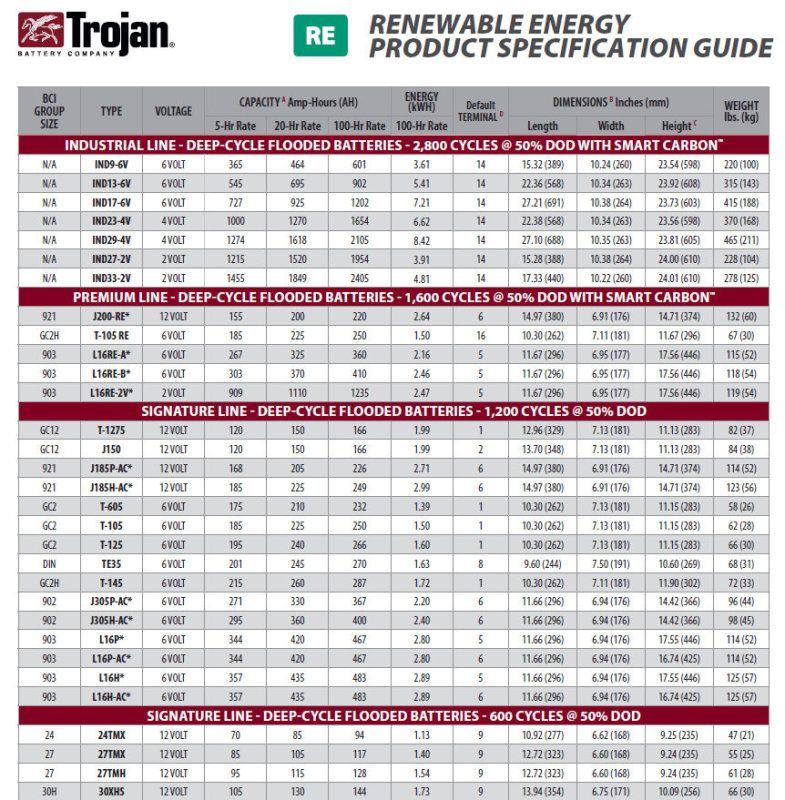
Here is a renewable energy document, solar/off grid is very similar to marine use, from Trojan which once again show the Group 24, 27 & 31 to deliver just half the lab rated cycles when compared to their golf and sweeper scrubber type batteries.
Of interesting note the newish Trojan T-105RE (RE=Renewable Energy) battery that delivers about 400 more lab cycles than the standard T-105.
Here’s the Crown Battery Data
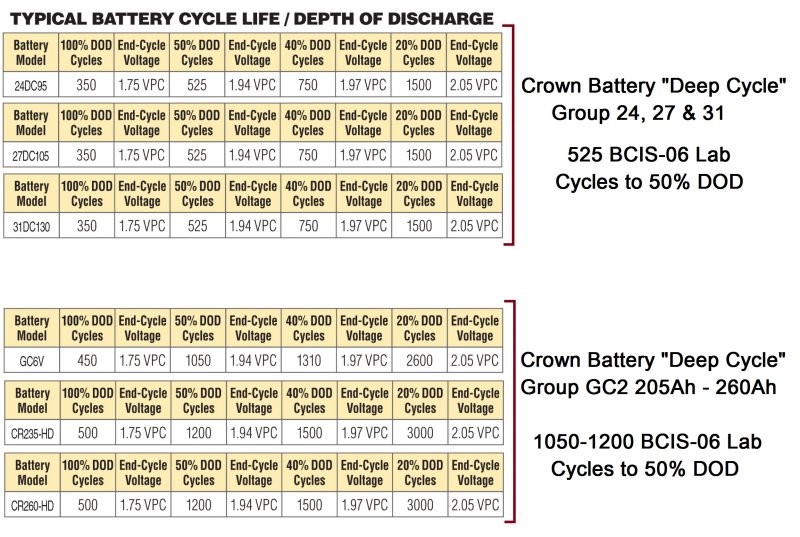
Here is the cycle life data from Crown Battery comparing their Marine Deep Cycle Group 24, 27 & 31 to their golf car / GC2 series.
The Crown Group 24, 27 & 31 deliver 525 lab cycles under BCIS 06 testing and their GC2 series deliver *1050 to 1200 cycles.
*The Crown GC6V is a price competitive 205Ah golf car battery.
Many companies, not just Crown, offer a low Ah (sub 210Ah), what I describe as, “home owner grade” or “condo complex” Golf Car battery to meet a competitive price point. These low Ah GC2 batteries often do not have the same exact cycling capability that a standard golf course grade GC2 battery has.
This 205Ah GC6V is not a battery that a golf course would generally purchase but rather a homeowner in a condo association that allows golf cars. Most all of the GC2 manufacturers offer a price-competitive GC2 battery, but they often don’t have the same cycling capability that a golf course grade GC2 has.
Generally speaking if you purchase a 6V GC2 battery with 210Ah to 225Ah, such as a; Trojan T-105, Deka GC15, Crown CR-235, US Battery US-2200 you’re going to be getting a golf course grade GC2 battery. Going much above 230Ah in a GC2 case means the plates can become uncovered when healing more easily than a standard GC2 battery. They are simply trying to stick more lead in there, and this is fine in a stationary application, but less good on a boat that heals.
Light Cycle vs. Deep Cycle
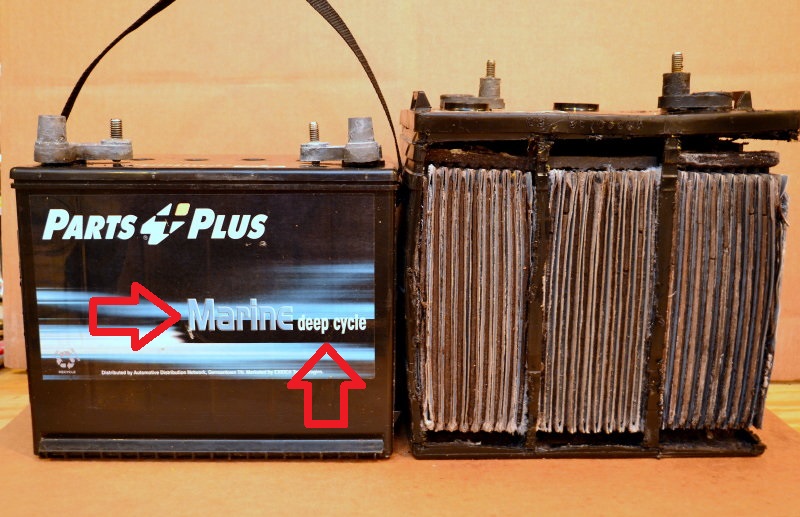
If you’ve been reading my stuff for any length of time you’ll know I like to look inside things, cut them open and autopsy them. Batteries have not escaped my fascination with power tools.
Right:
On the right we have a 235Ah GC2 6V golf cart battery. There are three cells in total and some nice room in the bottom of the case to catch any shed sulfate (think dead skin cells). The plate separators are a nice heavy rubber-like material. Batteries can occasionally short internally as shed sulfate piles up under the positive and negative plates. Once it builds up enough to touch we now have a cell that self discharges due to contact between a positive and negative plate…. The positive plates on this battery measured 0.121″ or just shy of 1/8″ thick.
Left:
Here we have another re-branded sticker shop Group 24 “Deep Cycle” battery. This one is actually manufactured by Exide and sold as a “Marine Deep Cycle”… Sure, if you say so. (grin)
Wow!!!
“Where’s the beef?”
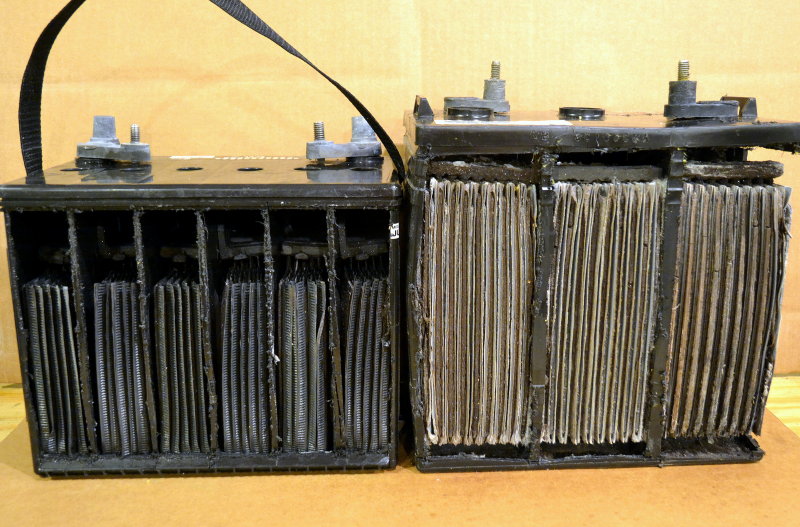
No, I am not kidding. This photo reminds me of the Wendy’s commercial from the early 80’s with the little old lady asking “Where’s the beef?” Laugh all you want but both of these batteries are sold & marketed as “Deep Cycle”. The only ones laughing are the battery makers, all the way to the bank, with YOUR money. Which one would you rather lay your hard earned money down on….???? Which one do you suppose is really capable of deep cycling…?
One glaring dissimilarity between these two batteries, besides the lack of lead on the 12V Group 24 pseudo deep cycle battery, is that this pseudo battery has very, very minimal room under the plates for any shed sulfate to collect. Also notice how much empty battery case is wasted on-top of the plates?
Big box, hardly any lead, while the golf cart battery is a taller box crammed chock full of lead. Both batteries take up virtually the same amount of floor space or foot print.
The big differences between the 12V deep cycle and the 6V deep cycle are more cycles, less cost per Ah, less cost per cycle. These benefits come at the slight impact of a bit more height to fit the golf cart battery.
If you have the height why would you use a more costly yet inferior product..??
Should a Yugo cost MORE than a Lexus? Would you pay MORE for a Yugo than you would for a Lexus? No, of course not, so why do that with marine batteries?
Plate Thickness:
- *6V GC2 235Ah = 0.121″ or just shy of 1/8″
- *Group 24 12V = 0.0617 or just shy of 1/16″
You actually read that correctly, the golf cart battery is almost double the positive plate thickness! Sometimes a picture is worth a thousand words, this one might be worth 1500…. (grin)
As I say repeatedly to my customers and consult clients;
“Deep cycle is often just a sticker, know what you are buying.”….
What about a “Starting” Battery?

This is one of the very few marine batteries I have replaced due to being chronically over charged. The owner of a center console placed an unregulated 15W solar panel on his T-Top and fed it directly to his East Penn/West Marine starting battery. About 9 weeks later the battery shorted internally due to crumbling plates and refused to start the vessel.
Look at the bottom of the battery case and notice how close the positive & negative plates are to the plastic. When the plates started crumbling, due to chronic over charging, brittle flaking lead fell to the bottom and created an internal short. The end cell, closest to you, was the shorted one according to specific gravity readings.
On the left you can also see how brittle the lead grid/plates had become due to over charging.
Starting vs. Pseudo Deep Cycle

On the left is the starting battery that was destroyed do to unregulated solar charging. On the right is a “light cycling” deep cycle murdered in less than one season by deep cycling, charging with only an automotive type alternator & PSOC use.
The Kirkland (Johnson Controls) “deep cycle” battery (on right) was brand new in May of 2015 (date code) and put into actual service in July. By October the battery was only delivering 28.2 Ah’s from its 115Ah factory rating! This battery was in parallel with a sister battery and both tested nearly identically. Let me sum this up……
THESE ARE NOT DEEP CYCLE BATTERIES!!!!!
Long and short I cut both of them open to expose the internal construction……
The Stickers

Here I’ve flipped the two Group 27 batteries around showing the stickers. I also laid out from L to R the negative plate, positive plate and the separators.
The West Marine battery is one of their highest CCA batteries (cold cranking amps) and the Kirkland is anything but a “deep cycle” battery despite what the BS on the sticker says.
Time & time again we hear how different starting and deep cycle batteries are, and when comparing a true deep cycle product to a starting battery, there are definitely some major differences.
In the case of these two batteries however the construction is more similar than different.
- Plate Separator Envelopes = Same Quality/Virtually Identical
- Negative Plates = Virtually Identical Thickness
- Positive Plates = Virtually Identical Thickness
- Plate Size = Deep Cycle Has Slightly Taller Plates
- Number of Plates = Starting Battery Has One More Plate Pair, Per Cell
“Deep Cycle” Group 27 – Positive Plate Thickness
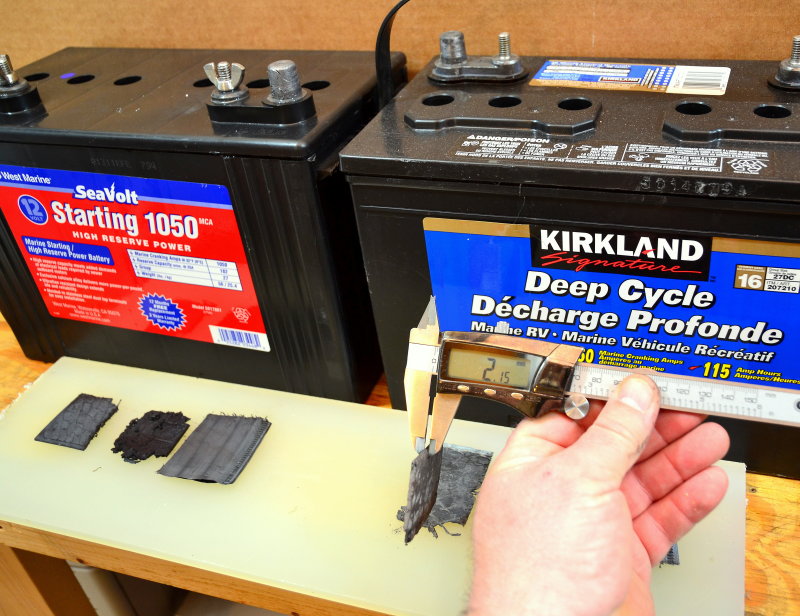
So how do they compare?
Deep Cycle “stickered” Group 27Battery:
- Slightly Larger Plates (taller)
- 6 pairs of positive & negative plates in each cell
- Positive Plate Thickness = 2.15 mm Thick (0.085″)
Starting Group 27 – Positive Plate Thickness
So how do they compare?
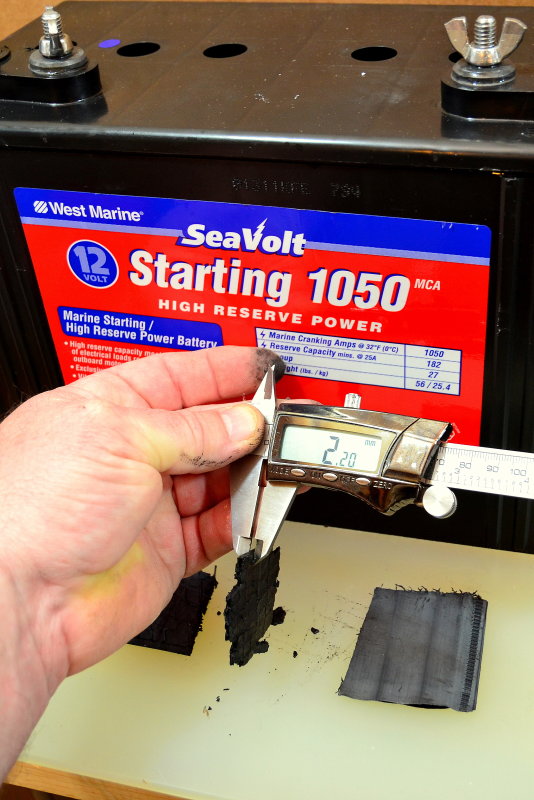
Starting G-27 Battery:
- Slightly Smaller Plates (shorter)
- 7 pairs of positive & negative plates in each cell
- Positive Plate Thickness = 2.20 mm Thick (0.087″)
Let’s break it down;
For years and years all we’ve heard is; “Starting batteries have many more plates & much thinner plates“.
Really? These are actual photos and they certainly don’t agree with the sentiment we’ve been fed?
The plates in this starting battery are actually 0.05 mm thicker than the deep cycle battery. D’oh… While the cells are slightly smaller in physical size they did cram one more positive and negative plate into the starting battery in order to deliver a slightly higher CCA rating.. This hardly qualifies as “many more plates & thinner plates”.
While these two batteries are from different manufacturers they all mislead the consumer. Sure, the plates are taller on the deep cycle but the positive & negative plates are virtually the same exact thickness on the starting battery as they are on the deep cycle.
This “deep cycle” stickered Kirkland battery lasted less than 35 real-world deep cycles. After those 35 cycles it could barely muster 28 Ah’s of accurately tested Ah capacity using lab grade test equipment.
Ask yourself, is this Costco/Kirkland/Johnson Controls battery really a deep cycle battery just because the sticker says so? If you think it is please call me, I have a bridge that’s a killer deal…(wink)
Distributor Level Branding

Many regional battery distributors, or “Sticker Shops” as I call them, re-label batteries to create more market share for a particular brand/manufacturer of battery.. The most often re-labeled batteries for marine use are Deka /East Penn, Johnson Controls, Superior and a few others.
The labels slapped onto batteries are occasionally not at all representative of the battery physically wearing the sticker.
For example I have seen many marine batteries that are actually 4D or 8D starting batteries labeled as either deep cycle or dual purpose. I have also seen 4D & 8D dual purpose batteries labeled as deep cycle.
West Marine is at least honest in their labeling of the Deka / East Penn 4D & 8D flooded batteries and they call them Dual Purpose but you can easily find these batteries re-labeld elsewhere wearing a deep cycle sticker.
Here is a good hint regarding 4D & 8D flooded batteries:
There is only one company I know of building a true “deep cycle” 4D or 8D flooded battery and those are hand made by Dyno Battery up in Washington state. Any other flooded 4D or 8D, no matter what the sticker says, is not a true deep cycle battery. Just because they are big and heavy, don’t be fooled by the sticker.
Regional Distributor “Sticker Shop” Issues:
Not to pick on Ultra Power, which are stickered up by a regional battery distributor, but it appears that when shipments get delayed, or stock gets low, I can occasionally find the same rating / specifications sticker on different batteries made by entirely different manufacturers. Scary stuff!!!!
Back in 2009 I had a customer with two Group 27 “Deep Cycle” Ultra Power EV27 “sticker shop” batteries. One was apparently physically made by Deka / East Penn and the other apparently by Johnson Controls. These batteries (pictured) were in a parallel bank and were flat-ass dead in under 2.5 years.
Despite being different products, manufactured by two different companies, both batteries had the same deep cycle specifications of 110Ah on the Ultra Power sticker. Deka to my knowledge has not manufactured a 110Ah deep cycle Group 27 marine battery.. Odd at best….
Look very closely at these two batteries, bought the same day, at the same vendor and labeled identically. The cases are not even close to the same design, the terminals are different, the handles are different, the caps are different and they are likely not both 110Ah batteries.
Caveat emptor when buying sticker shop batteries!
P.S This installation is not and was not my work!
Distributor Level Mislabeling
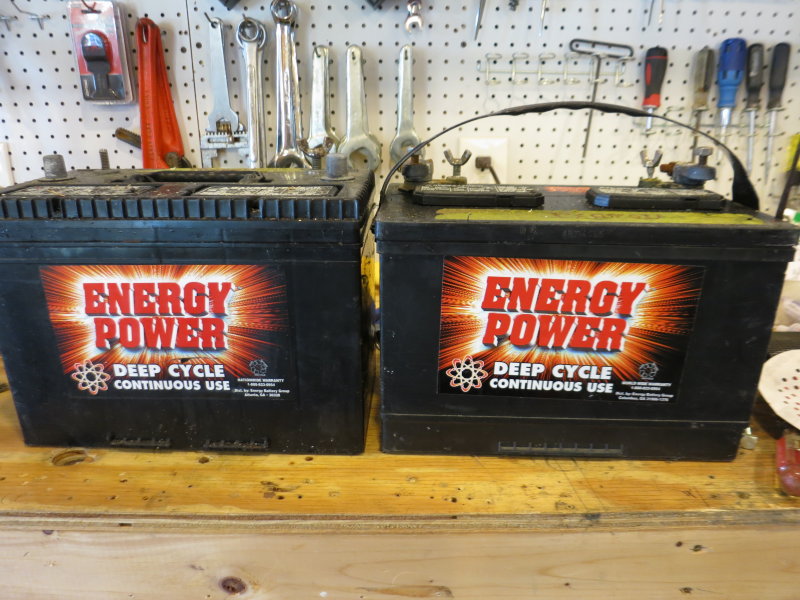
Here again we have two batteries wearing the same distributor level specifications, and stickers, but they tested differently, when brand new, and were so far apart as to not even be in the same ball park. Heck based on case identification they don’t even appear to be made by the same manufacturer. Coincidentally the specification stickers suggest they are identical batteries….
Distributor Branding = BUYER BEWARE!!
Deep Cycle 12V Group 24 vs. 6V GC2
Why 6V batteries?

#1 They are more durable than 12V Group 24, 27 & 31 marine batteries because they are designed for the rigors and abuses of rough-riding golf carts. They are simply more robustly built often with better separators and always with more lead and thicker plates. While thicker plates do not always make a battery deep cycle, when talking 6V Golf Cart batteries compared to typical 12V Group 24, 27 & 31 this is a truism.
#2 They have considerably longer cycle life than 12V flooded pseudo deep cycle batteries and even in the real world this tends to translate out to approx one third to double more the life of the average 12V flooded battery.
#3 You can fit more Ah’s in a smaller foot print but they do require some additional height..
#4 Price wins! Ignore the West Marine pricing and shop other places. You’ll see the cost per Ah and per cycle between 12V flooded batteries and GC2 6V golf cart batteries becomes even more apparent. The GC2 230Ah battery pictured at the top of this article can also be purchased as a Duracell EGC2 at about half the Sam’s Club’s in the US. This means $109.00 at Sam’s vs. $199.99 at West Marine. The only difference between these two batteries is the sticker that East Penn installs at the factory.
Take a close look at the foot print these two 6V GC2 batteries take up compared to two Group 24 deep cycle batteries. The only sacrifice you need to make, to get all the benefits of golf cart batteries, on your boat, is a little more height to fit the GC2’s.
Don’t Limit Yourself

Don’t limit yourself to just the typical deep cycle batteries you may find at a chandlery or marine store. This is a 400Ah bank consisting of two Trojan L16 size 6V batteries. While L16’s are much taller than 12V batteries, or even GC2 6V batteries, they take up less foot print. For this owner, he had the height, but not the foot print. These two batteries are sitting where two Group 27’s used to be and he now has 400 Ah’s vs. approx 180 Ah’s in the same exact foot print.
“But RC what if I don’t have the height to fit actual deep cycling batteries?”
There are a few way’s to look at this:
#1 Accept your limitations, accept that the marketing is misleading, and just stick with a premium quality “light cycling” Group 24, 27 or 31 flooded battery such as a Crown, Trojan, US Battery or Deka and replace it when it dies. Rolls actually makes a fairly deep cycle Group 27 & 31, though not quite the same as their GC2’s but closer than most, however they are God awfully expensive.
With good care in a coastal cruising application light cycling batteries can still certainly deliver an acceptable life for the cost outlay. If you practice good battery care you may be able to eek out another 6 months to a year beyond where you are now. Cost is minimal & no modifications. Upgrade cost = $
#2 Move to a premium AGM (Lifeline, Odyssey, Northstar, Firefly) or GEL (Deka, Trojan or Sonnenschein/Prevailer) battery. In the Group 24, 27, 31 4D & 8D both premium AGM and GEL are true deep cycle products.
AGM’s & GEL’s are arguably a bit temperamental in how they are cared for, and charged, and these batteries really need to be installed as a “system“. The charging system upgrade costs can far exceed the cost of the batteries. These batteries are simply too expensive to not install correctly. Done correctly AGM can often approach & some can exceed 6V GC2 life and GEL’s often exceed it.
Of course, like anything, there are always outliers. You can murder expensive AGM’s & GEL’s just as fast as “light cycling” batteries if the system & use is not done correctly. GEL batteries are pretty much the hands down kings of small case cycle life. The Deka GEL is rated at 1000 cycles. I have a number of GEL banks out there well beyond ten years and one into its 17th as of March 2017. My friend Bruce went around the world TWICE in the same set of GEL batteries. Upgrade cost = $$$$$
#3 If you’re going to be doing some serious cruising, consider relocating your house batteries and fabricate / build a new space for them. You can leave the starting battery as a light cycling type, in the original location, and just revamp the house bank. Upgrade cost = $$
Sometimes when you factor in how long you plan to keep the boat, sticking with light cycling batteries, despite the hit in cycle life, may win the value game.
There are Also 12V Golf Cart Batteries
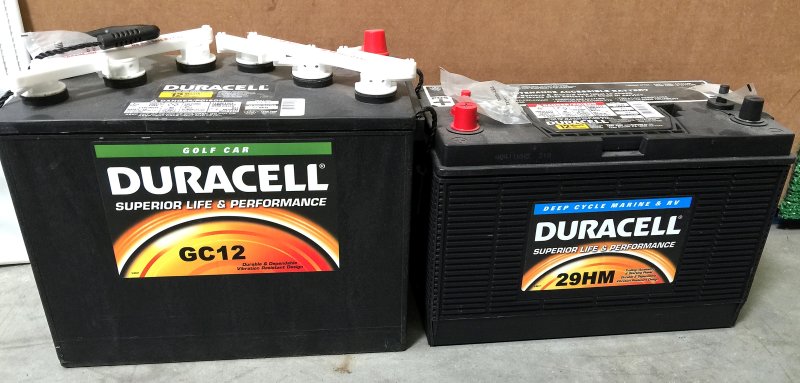
If you are uncomfortable wiring 6V batteries in series or series/parallel you can always purchase golf car durability in a 12V battery. The battery on the left is a golf car 12V battery. This Duracell GC12 is purposely placed next to a Group 31 12V battery. While it’s certainly taller they will usually fit where a Group 31 did and often a where Group 27 did.
The BCI group size of GC12 is far too often over looked in the marine industry. GC12 batteries are usually between 145Ah and 155Ah in a 12V case/form factor.
GC12 Brands/Models Include:
- Deka / East Penn = GC12 (the Duracell pictured is an East Penn GC12)
- Crown = CR-GC150 or CR-GC155 (Crown’s are very attractively priced)
- Trojan = T1275 or J150
- Interstate = 12VGCUTL
- US Battery = US 12VE XC2 or US12V XC2
Many Ways To Configure Banks
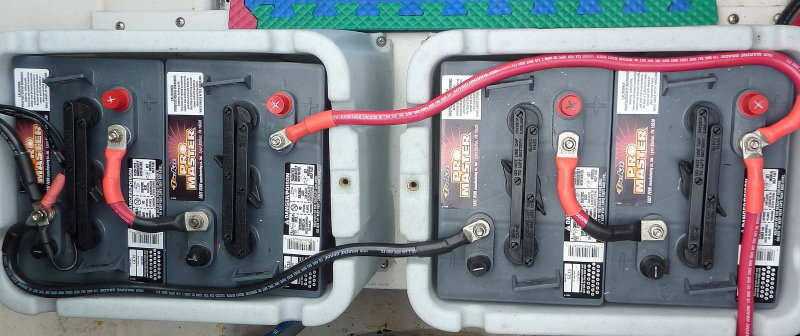
As I mentioned before don’t limit yourself in creating a good deep cycling bank for yourself. The options are almost limitless and even 2V batteries, such as those by Rolls/Surrette are available, These large heavy 2V cells are a true 15+ year battery and are the true Kings of the deep cycle world.
Here we are looking as a SERIES/PARALLEL configuration of four 6V 230Ah GC2 batteries. This yields an effective bank size, in a series/parallel configuration of 460Ah’s at 12V.
SERIES:
When you connect two 6V DC batteries in series, negative terminal of battery #1 to positive terminal of battery #2 you’ve now created a single 12V deep cycle battery.
12V batteries are nothing more than 6 series-wired cells inside a single plastic case. A 6V battery is three series wired cells inside a single plastic case. All you are doing for a 12V bank using 6V batteries is wiring them externally in series.
In SERIES wiring of 6V batteries we ADD VOLTAGE but AMP HOUR capacity stays the same.
SERIES 6V + 6V = 12V
Two 230Ah Batteries In Series = 230Ah’s
PARALLEL:
In Parallel wiring we add AMP HOURS but VOLTAGE stays the same.
PARALLEL 12V + 12V = 12V or 6V+6V = 6V
Two 230Ah Batteries In Parallel = 460Ah’s
SERIES/PARALLEL:
In series parallel (pictured) we wire in series first, to attain desired voltage, then we wire in parallel to gain capacity.
This bank consists of two series wired banks to attain 12V each. These series banks were then paralleled to created a 460Ah house bank.
Series Parallel = Less Than Optimal
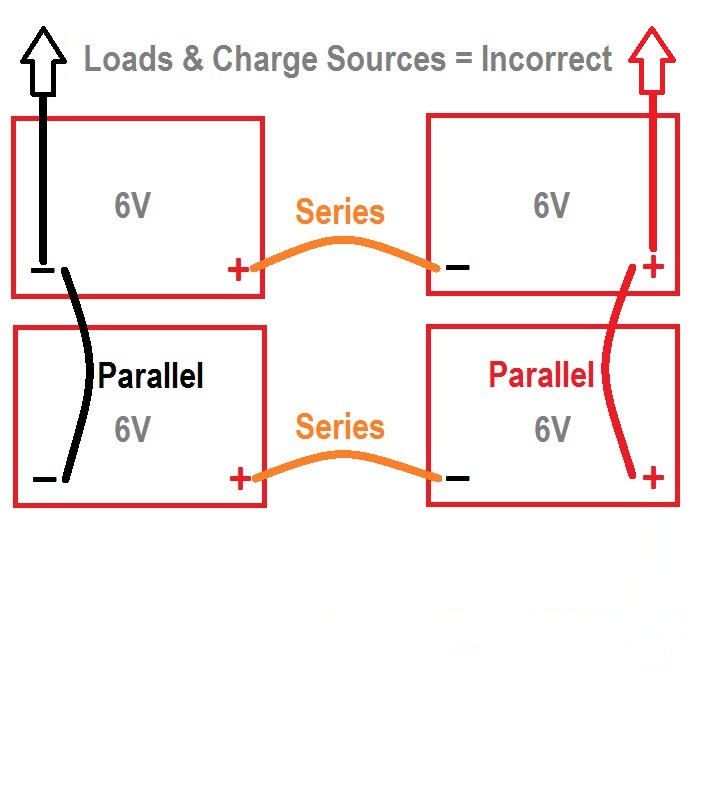
While these take off points from the series parallel bank can work, and give you 12V, it is less than ideal. Every battery manufacturer I know of advises against wiring a series parallel bank in this manner.
Don’t Just Take Our Word For It
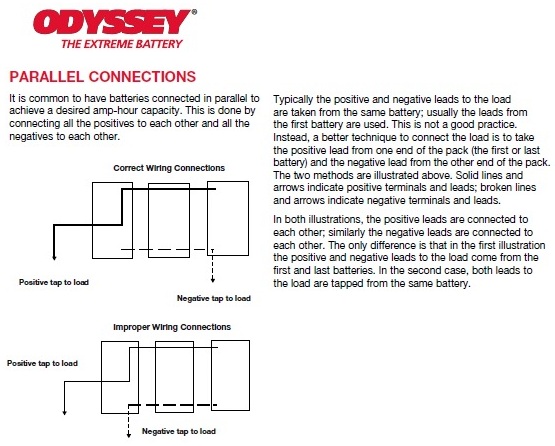
EnerSys, the inventors of the Odyssey TPPL AGM battery as well as the inventors of the Optima battery, and the leaders in standby back up systems, military applications and other industrial battery applications spells out correct parallel wiring better than I can. When you are wiring series banks in parallel this applies.
Quote = Odyssey/Enersys:
“Parallel Connections:
It is common to have batteries connected in parallel to
achieve a desired amp-hour capacity. This is done by
connecting all the positives to each other and all the
negatives to each other.
Typically the positive and negative leads to the load
are taken from the same battery; usually the leads from
the first battery are used. This is not a good practice.
Instead, a better technique to connect the load is to take
the positive lead from one end of the pack (the first or last
battery) and the negative lead from the other end of the pack.
The two methods are illustrated above. Solid lines and
arrows indicate positive terminals and leads; broken lines
and arrows indicate negative terminals and leads.
In both illustrations, the positive leads are connected to
each other; similarly the negative leads are connected to
each other. The only difference is that in the first illustration
the positive and negative leads to the load come from the
first and last batteries. In the second case, both leads to
the load are tapped from the same battery.
The first schematic is recommended whenever batteries
are hooked up in parallel to increase battery capacity.
With this wiring, all batteries are forced to share both charge
and discharge currents. In contrast, a closer inspection
of the second schematic shows that it is possible for only
the battery whose terminals are tapped to support the load.
Implementing the first schematic eliminates this possibility
and is therefore a better one.”
End quote:
Trojan Parallel Takes Offs
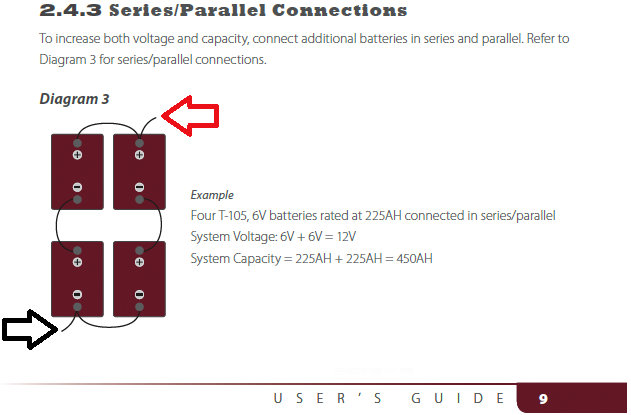
Here is Trojan’s diagram.
This information is out there and easy to find, but from what I see on boats, it is not widely looked at. Optimal battery life in the real world is a complex puzzle. All the small pieces ideally need to fit for the best cycle life..! Wiring your bank, as it should be, is one of those small puzzle pieces…
Series Parallel = Optimal
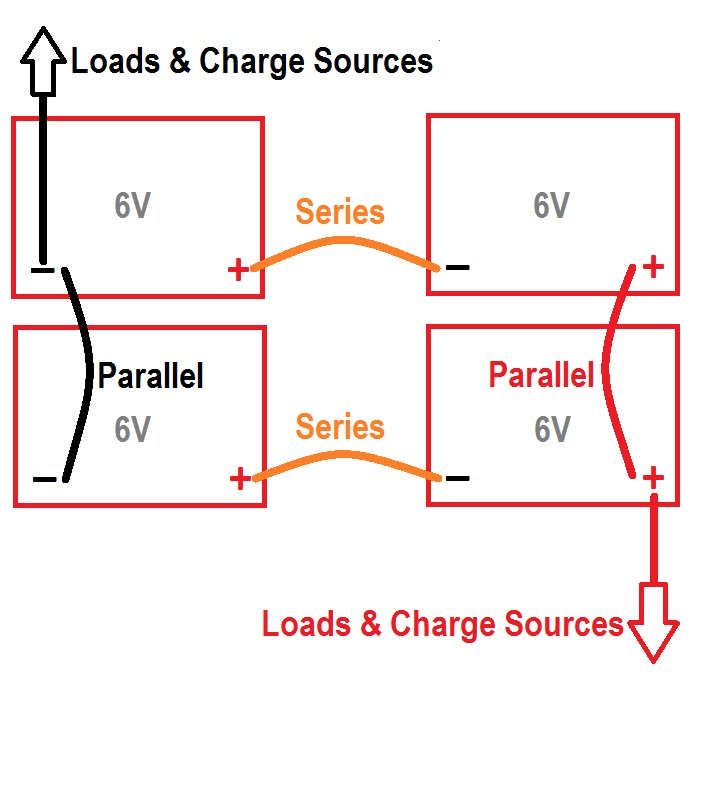
When wiring a bank for series / parallel you will first want to fit and orient the batteries as they will be physically installed on the boat. You then construct the series jumpers and wire them.
Once you’ve created your series 12V banks you can then wire them in parallel. As explained above, by EnerSys/Odyssey Battery, it is good practice that the loads and all charging inputs be wired from opposite ends or corners of the bank, as shown. This helps keep the bank in better balance throughout its life.
With a series parallel set up the terminals you connect the boat to are those two corners. You do not want to “center tap” with a 6V series or series/parallel bank otherwise you may not have a 12V bank for that circuit..
Final Thoughts:
Can 12V Group 24, 27, 31, 4D & 8D flooded batteries work? Sure, absolutely, and they do in the tens of thousands on boats every day. The question here is of value and are you getting what you paid for, or were sold, when you bought what you thought was a deep cycle battery…?
When a 12V flooded marine “deep cycle” battery is sold for more money, and with half the rated lab cycles, my thinking is a flat out no.
When purchasing house bank deep cycling batteries you should always consider cycle life. This is the part most everyone buying batteries forgets or entirely leaves out of the decision making process.
The battery buying process is not just about Amp Hours and $$$. It’s Ah’s, $$$ and cycle life.
By labeling “light cycling” batteries as deep cycle the battery maker wins because you buy more batteries in a shorter period of time. Do your home work and don’t get bitten by the marketing mumbo-jumbo.
Good luck & happy boating!
Like What You Saw Or Read?
Would you like to see more articles like this? Is so feel free to donate, support the site and keep it growing.
Your donations help keep the content coming and to keep www.MarineHowTo.com a free site.
Click the DONATE button below if you would like to make a donation via PayPal.

